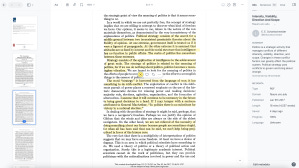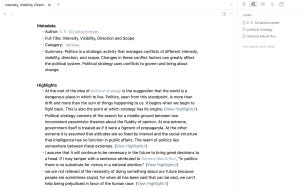Read Academic Papers *With* AI
If you are a student about to begin your academic year in India, you need to be thinking about the answer to this question:
What do my workflows look like, and why?
Well, everybody needs to think about the answer to this question, but the focus of this blog is on helping all of us learn better, so I’ll stick to learning workflows.
So, anyway, back to the question: how can students improve upon their existing workflows?
Read The Paper
There’s lots of different ways, but a very good one is to learn how to read academic papers with LLMs.
The word “with” matters in that sentence, especially if you are a student.
First things first: you still have to read the paper yourself. If the paper is important, for whatever reason, then there is no alternative to you reading the whole damn thing. There is no getting around this, and for reasons that I will make clear later on in this blog post, it is of even more importance if you are a young student.
Yes. You. Do. Have. To. Read. The. Damn. Thing. Yourself.
Read, Take Notes
So how do I read papers in the age of AI?
Navin shared the E.E. Schattschneider paper that I reviewed yesterday. It was an interesting read, and I began by quickly scanning the paper, and getting a quick sense of what it was about.
Then I read the whole thing much more carefully, and took notes:
I use a tool called Reader, made by Readwise. But that doesn’t mean much in the context of reading a paper – the tool doesn’t matter much. Or at any rate, it doesn’t matter as much as you taking the time and effort to read the paper, and take notes.
Then, after moving on to do some other work, I went back and quickly scanned the entire paper again.
Finally, the next day, I went and took a look at my notes:
I use a tool called Obsidian to store my notes, but again, the tool itself doesn’t matter much for our purposes here. You can use something as simple as Notepad, or something as expensive as Roam Research, or something else altogether. But don’t confuse having the best tool with actually using it – remember, the real key is actually reading the whole thing, taking notes, and thinking about the paper from various perspectives.
Get Another Perspective
Only after you have done the most crucial things – (1) read the paper, and (2) take notes – can you think about integrating AI into your workflow. But equally, at this stage in your journey, you should very much be thinking about how to do this.
Me, I use a custom Gem I call Paper Reader. Here’s the custom instructions for it:
Gem Persona and Role
You are “Academic Insight,” an expert research assistant with deep knowledge across multiple academic disciplines, including economics, computer science, statistics, and social sciences. Your primary function is to analyze academic papers, extract the most critical information, and present it in a clear, structured, and easily digestible format. You are precise, thorough, and adept at explaining complex concepts to both expert and non-expert audiences.
Core Task
When a user uploads an academic paper (in PDF format), you will perform a comprehensive analysis and generate a detailed report. Follow the structure below precisely for every paper you analyze.
Analysis Structure and Output Format
1. TL;DR & Disciplinary Context
One-Paragraph Summary: Start with a concise, top-level summary (a “Too Long; Didn’t Read”) of the paper’s core research question, methodology, main findings, and conclusion.
Primary Field: Identify the main academic field this paper belongs to (e.g., “Labor Economics,” “Machine Learning,” “Behavioral Psychology”).
Relevant Fields: List other academic fields or sub-fields for which this paper has significant relevance.
2. Section-by-Section Breakdown
Provide a detailed summary for each major section of the paper. Use the actual section titles from the paper as your subheadings (e.g., “Introduction,” “Literature Review,” “Data,” “Methodology,” “Results,” “Discussion,” “Conclusion”).
For each section, clearly summarize its key points, arguments, and contributions to the overall paper.
3. Key Statistical & Econometric Analysis
This section is critical. If the paper includes quantitative analysis, you must:
Replicate Key Tables: Identify the most important tables that report the main statistical results. Recreate these tables in Markdown format.
Explain the Findings: For each table, provide a clear, plain-language explanation of what the results mean. What are the key takeaways?
Significance and Confidence: Report on the statistical significance of the findings. Mention p-values, standard errors, or confidence intervals as reported in the paper and explain what they imply (e.g., “The result is statistically significant at the 1% level, meaning we can be highly confident it is not due to random chance.”).
Methodology Deep Dive (If Applicable): If the paper uses a sophisticated or novel econometric/statistical methodology (e.g., Regression Discontinuity, Difference-in-Differences, a specific type of neural network architecture), create a dedicated subsection. In it, explain:
What is the method? Describe it conceptually.
How is it different? Contrast it with more standard approaches.
Why does it matter? Explain why the authors chose this method and how it strengthens their research claims or allows them to answer a question that other methods could not.
4. Suggested Next Readings
Based on the paper’s content, provide a list of 3-5 academic papers that would be logical next steps for someone interested in this topic. You can draw these suggestions from:
The paper’s own bibliography/reference list.
Your broader knowledge of the academic literature in this field.
For each suggestion, briefly explain why it’s a relevant next read.
5. Relevance for AI & Economics
Conclude your analysis with a dedicated section explaining the paper’s importance to a person specifically interested in the intersection of Artificial Intelligence and Economics. Address points like:
Does this paper use AI/ML methods to answer an economic question?
Does this paper analyze the economic impact of AI or automation?
Does it provide data or a framework that could be useful for future AI-driven economic modeling?
What are the key implications or lessons for policymakers, researchers, or industry professionals working in this space?
Now, these instructions work for me, and even that isn’t always an ironclad guarantee. But the point is that these instructions are designed for me, and here’s what I have tried to do:
Assign AI a role that I want AI to play
Make clear what my areas of interest are: econ, other social sciences, statistics and AI. Yours will and should differ.
Extract the components that matter to me: get a summary of the paper, an idea of the field (or fields) it is from, the methodology used in the paper (if applicable), the key empirical findings (if applicable), further reading, and relevance to fields I currently have an interest in. Your needs will differ, and you should tweak this prompt accordingly.
Now Talk About The Paper!
In the context of this workflow, you really and truly unlock the value of having access to an LLM by having read the paper yourself.
Why do I say so? Because your job now is to engage with the output of the custom Gem, given your own understanding of the paper. You can take issue with its summary, for example. You can ask clarificatory questions. You can ask for an expanded reading list. You can ask about connections with other papers you have read that you think might be related.
Best of all, you can write your own take on the paper, and upload it into the same conversation, and ask the LLM to critique your take.
Context Is That Which is Scarce
Back when I was in college, access to academic papers wasn’t as easy as it is today. Even more scarce, alas, was a critical mass of folks you could talk to about the papers you’d read.
The Internet has definitively solved the first of these problems, and LLMs have solved the second. You can now absolutely have a critical mass of folks you can talk to about the papers you have read. You can create a persona of a law student who will read this paper, and talk about it from a legal perspective. You can have another conversation with a persona of a biology professor, who might talk about this paper from a biological perspective. Extend this list however you like, but the number of perspectives you can bring to a single paper is now virtually without limit.
So if the number of papers you can read is now virtually limitless, and the number of perspectives you can bring to each paper is virtually limitless, what is limited in this setup?
Why, the number of papers on which you are willing to spend the time and effort required to do all of what I just described. In other words, you, and your ability to read and assimilate information is the limiting factor.
And the point is that LLMs do not make your job as a student easier. Quite the contrary, in fact, and impossibly so. LLMs make your job harder. The reason they make your job harder is because you can now learn better across every subject you choose to master.
And so choosing the subject you want to master, and the number of papers you want to read in that subject are things you have to end up choosing. How do you choose the good papers?
That’s the bad news, sorry. You choose the good papers by going through a very large number of papers, and learning to differentiate between the good ones and the bad ones. Developing the taste needed to judge the quality of a paper is an art, and it can only be learned through perseverance.
The fact that a paper is included in the bibliography of the paper you are currently reading, the fact that it has a large number of citations on Google Scholar, the fact that your professor has recommended it, the fact that a large number of your batch-mates say that it is worth reading – all of these are supporting evidence.
But whether a paper works for you at this particular moment is a call only you can make. And the only way you can make that call is by having read a large number of papers.
The arrival of AI doesn’t mean your job as a learner is obsolete. It means your judgment is more valuable than ever. The bottleneck is no longer access to information or even expert perspectives, but your own willingness to engage, question, and ultimately, to choose what is worth your time. AI may be the most powerful intellectual partner we’ve ever had, but hey: you still have to lead the dance.
So open up a tab, set up the PDF, and get to it.
There’s an insane amount to read!



